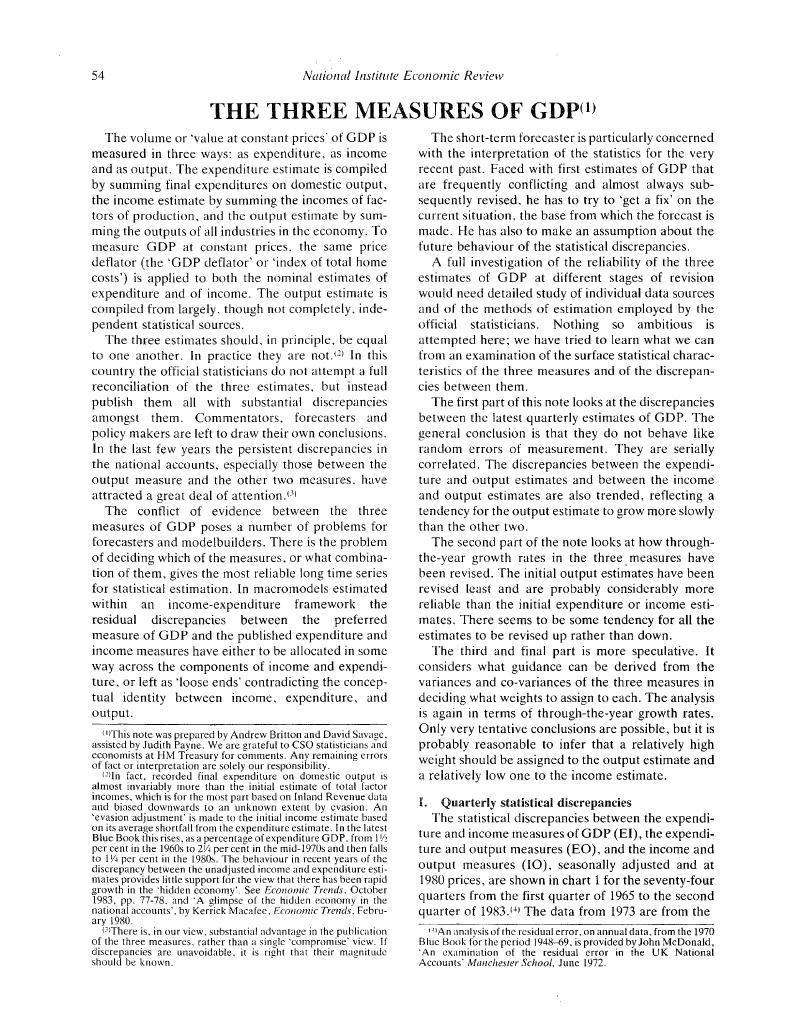Article contents
The Three Measures of GDP
Published online by Cambridge University Press: 26 March 2020
Abstract

- Type
- Articles
- Information
- Copyright
- Copyright © 1984 National Institute of Economic and Social Research
References
Notes
note 1 in page 54 This note was prepared by Andrew Britton and David Savage, assisted by Judith Payne. We are grateful to CSO statisticians and economists at HM Treasury for comments. Any remaining errors of fact or interpretation are solely our responsibility.
note 2 in page 54 In fact, recorded final expenditure on domestic output is almost invariably more than the initial estimate of total factor incomes, which is for the most part based on Inland Revenue data and biased downwards to an unknown extent by evasion. An ‘evasion adjustment’ is made to the initial income estimate based on its average shortfall from the expenditure estimate. In the latest Blue Book this rises, as a percentage of expenditure GDP, from 1½ per cent in the 1960s to 2¼ per cent in the mid-1970s and then falls to 1¼ per cent in the 1980s. The behaviour in recent years of the discrepancy between the unadjusted income and expenditure esti mates provides little support for the view that there has been rapid growth in the ‘hidden economy’. See Economic Trends, October 1983, pp. 77-78, and ‘A glimpse of the hidden economy in the national accounts’, by Kerrick Macafee, Economic Trends, Febru ary 1980.
note 3 in page 54 There is, in our view, substantial advantage in the publication of the three measures, rather than a single ‘compromise’ view. If discrepancies are unavoidable, it is right that their magnitude should be known.
note 4 in page 54 An analysis of the residual error, on annual data, from the 1970 Blue Book for the period 1948-69, is provided by John McDonald, ‘An examination of the residual error in the UK National Accounts’ Manchester School, June 1972.
note 1 in page 55 The expenditure and income estimates for the first two quar ters of 1983 have been corrected for an error reported in a press release of 11 November.
note 2 in page 55 As established below, EO and IO have upward trends. Since they are constrained to zero in 1980. which is near to the end of the period, their means are negative.
note 1 in page 56 In accordance with the usual terminology, ‘significant’ is used to mean significant at the 95 per cent level.
note 2 in page 56 In calculating the evasion adjustment, the CSO took a central six-year moving average of the initial residual difference. To the extent that such a method is not sensitive to shorter-term trends in the hidden economy, such trends remain in the ‘residual error’ and could show up as a serial correlation.
note 3 in page 56 The regressions reported in table 2 were repealed with EI, EO and IO, and their lagged values expressed, not in absolute terms, but as ratios to GDP. The results are very similar.
note 4 in page 56 Every five years or so there are also revisions when the base year is changed for the output estimate and for the price detlator used to derive the constant price expenditure and income estimates from current price figures.
note 5 in page 56 ‘The assessment of the National Institute's forecasts of GDP, 1959-82’, National Institute Economic Review no. 83, August 1983. The data for more recent years will, of course, have gone through fewer successive revisions than the data for earlier years.
note 1 in page 57 These revisions include the effect of rebasing which is known to have substantially increased growth rates on at least one occasion (because the growth of oil production was given a higher weight at 1975 prices than at 1970 prices).
note 2 in page 57 Throughout this note we consider error variance rather than the sum of squared errors. These will differ to the extent that mean errors are not zero. In fact, as shown above, the discrepancies between GDP measures suggest mean errors in growth rates which are close to zero, but not precisely zero. Correcting the calculations for these non-zero means does not, in this case, alter the qualitative conclusions. Moreover the information contained in those mean errors is more likely to mislead than to help in this context. In particular the mean error in the discrepancy between the growth rates of the expenditure and income estimates is very close to zero by construction.
note 3 in page 57 There may however be some correlation as some of the indica tors used to derive the output estimate are used in the compilation of the income and expenditure measures. There may also be some tendency for judgemental adjustments to each of the measures to be influenced by the behaviour of the others.
note 1 in page 58 The data used, which cover the period 1959-82, are set out in table 5 of the note on forecasts of GDP in last August's Review, op. cit., p. 34.
- 2
- Cited by


